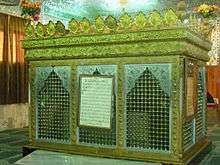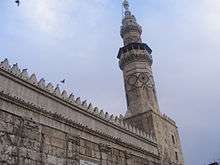Hujr ibn 'Adi
| Hujr ibn 'Adi حجر بن عدي (Arabic) | |
|---|---|
 His shrine before being desecrated in 2013 | |
| Died | 660 CE |
| Cause of death | Death sentence ordered by Umayyad Caliph Muawiyah I |
| Resting place |
Adra, Syria 33°36′27″N 36°31′3″E / 33.60750°N 36.51750°E |
| Known for | being a supporter of Ali |
| Children | Humaam ibn Hujr |
Hujr ibn 'Adi al-Kindi (died 660 CE) was a companion to the Islamic prophet Muhammad.[1] He was sentenced to death by the Umayyad Caliph Muawiyah I for his unwavering support and praise for Ali, the fourth Rashidun Caliph of Islam and the first Imam of the Shias,[2][3] when he objected to the tradition of publicly cursing Ali and continued to condemn Uthman for his corruption. He belonged to the tribe of Kindah.
Hujr's titles
Hujr was given two titles: "al-Kindi" and "al-Adbar". The first title was "al-Kindi", meaning The Person From Kindah, an Arabian tribe. The second title given to Hujr was "al-Adbar".[4]
Character and life
According to some narrations, his last wish was that his son should be executed before him lest death terrify him (his son) and therefore accede to the condition of cursing Ali.[5]
Desecration of shrine

Hujr, his son Humaam ibn Hajar, and some other companions are buried in Adra, in the outskirts of the Syrian capital Damascus. A mosque had been built around his grave which became a pilgrimage site for Muslims.
According to Iranian reports, on 2 May 2013, extremists (allegedly from the Wahhabi movement) attacked the mausoleum and exhumed his remains.[6] His body was taken to an unknown location by the rebels.[7] According to a report published in the New York Times, a widely distributed Facebook photo of the desecration of the pilgrimage site gives credit for the exhumation to a man named Abu Anas al-Wazir, or Abu al-Baraa, a leader of a military group called the Islam Brigade of the Free Army.[8][9]
See also
References
- ↑ "Soften your heart, learn about Hujr ibn 'Adi al-Kindi – Islamic Philosophy". islam.hilmi.eu. Retrieved 2018-08-21.
- ↑ "Hujr bin Adi al-Kindi:The Great Martyr". imamreza.net. Retrieved 5 May 2013.
- ↑ Tareekh e Dimshaq
- ↑ Ibn Muḥammad (Ibn-ʻAbd-Rabbihī), Aḥmad. The Unique Necklace "al-ʻIqd Al-Farīd" Trans. Issa J. Boullata. Vol. 3. Reading, UK: Garnet Publishing Limited, 2007. Print. ISBN 1859642403 Pg. 289
- ↑ "Shrine of the great companion Hijr ibn Adi destroyed and body reportedly exhumed". aimislam.com. 2 May 2013.
- ↑ "Syria militants exhume grave of Prophet's companion". Press TV. 2 May 2013. Archived from the original on 5 May 2013. Retrieved 5 May 2013.
- ↑ Press TV, May 3rd 2013
- ↑ ERDBRINK, THOMAS (6 May 2013). "Iran Warns Syrian Rebels After Report of Shrine Desecration". New York Times. Retrieved 7 May 2013.
- ↑ "Syrian rebels have taken iconoclasm to new depths, with shrines,". The Independent. Retrieved 22 December 2013.